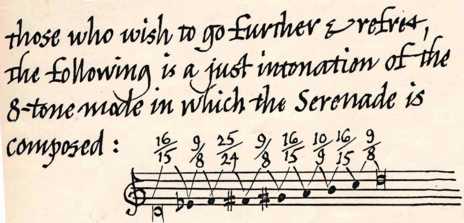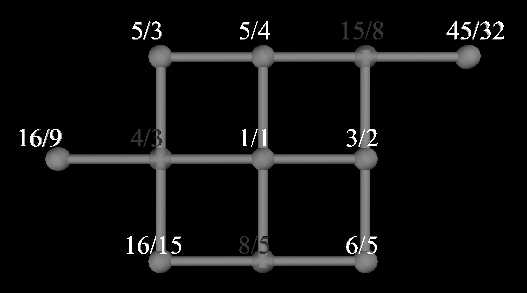
The fingerboard used by John Schneider in his recording of the Serenade

This unusual octatonic scale alternates semitones and whole tones, but each of two different sizes. Here is the same scale with some extra information:
| Pitch | D | Eb | F | F# | G# | A | B | C | D | ||||||||
| Ratio from 1/1 | 1/1 | 16/15 | 6/5 | 5/4 | 45/32 | 3/2 | 5/3 | 16/9 | 2/1 | ||||||||
| Cents from 1/1 | 0 | 111.7 | 315.6 | 386.3 | 590.2 | 702 | 884.4 | 996.1 | 1200 | ||||||||
| Frequency | 293.3 | 312.9 | 352 | 366.7 | 412.5 | 440 | 488.9 | 521.5 | 586.7 | ||||||||
| Ratio between pitches | 16/15 | 9/8 | 25/24 | 9/8 | 16/15 | 10/9 | 16/15 | 9/8 | |||||||||
| Cents between pitches | 111.7 | 203.9 | 70.7 | 203.9 | 111.7 | 182.4 | 111.7 | 203.9 |
"Cents" is a measurement of interval size that is easier to grasp than ratios, because they represent an exponential scale like our perception. An octave divides into 1200 cents, so that each equally tempered semitone is exactly 100 cents. The above table shows that Harrison's semitones are both larger (111.7 cents) and smaller (70.7 cents) than an equally tempered semitone, for example. For the mathematical details, click here.
Another way to view a just intonation scale is as a "lattice" diagram. This view allows one to easily grasp where the just fifths (3/2 ratios) and just major thirds (5/4) lie. In the following diagram, each pitch is represented by a dot (or sphere). Pitches connected by a horizontal line are related by a 3/2 (or equivalently, a 4/3, depending if one is reading left to right or right to left). Vertical lines connect pitches related by a 5/4.
The scale of the Serenade lacks three pitches necessary to show a complete lattice. These pitches are shown in dark gray with translucent spheres.
